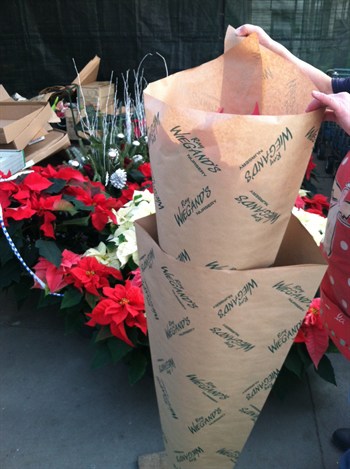Protecting poinsettias and houseplants in transit
Be careful with indoor plants in drafts or where doors are
propped open to frigid air.
This article is Sponsored by:
Although some indoor plants can handle
cold blasts, protection is critical when it comes to newly
acquired or relocated plants. Chief among them, poinsettia
(Euphorbia pulcherrima) and amaryllis
(Hippeastrum varieties), which face big, sudden changs as
they travel in-out-in from store to home.
Every year a lot of money is wasted because poinsettias become
useless as decorations after their leaves turn black. The people
involved may never know that it was that trip home from the store
through cold air that killed the leaves or stems or both, because
the
symptoms may not show up for a day or two.
For shame!
Shame on retailers who let this happen. In the winter, indoor
plants should be wrapped for the trip between store and car, car
and home. If there's no wrapping going on, or plastic is being used
as wrappers, say "No thanks." If the staff is ignorant of the need
to keep warm air around the plant, they are probably ignorant of
its other needs and it's suffered while in stock.
Take a look:
Professor Linda Chalker-Scott of Washington State University
co-produces an excellent science-based garden blog and podcast,
including an episode with illustrations of cold damage to an Aglaonema/Chinese
evergreen houseplant.
Count to five, poinsettia stays alive!

You'll almost always receive better quality and care when buying
plants from garden centers, as compared to department stores and
grocers. Buy your plants there.
The staff at Ray Wiegand's Nursery in Macomb, Michigan, gave us
this demonstration of proper wrapping using paper sleeves.
Photos copyright Ray Wiegand's Nursery.
- Drop the plant into a paper sleeve.
- If the plant is taller than the sleeve, double up the
sleeve.
- Now pull the sleeve up around the plant -- the leaves will bend
gently up and in.
- When there is enough paper above the plant to fold over…
- …close the sleeve and staple it.
Other wrappings that work
Tightly closed cardboard boxes or Kraft paper bags (including
grocery bags). Cut the bottom out of the inner bag to
double-sleeve, or invert bag 2 over the plant and tape the open
tops together.
Never use plastic, which has no insulating quality. It can trap
some warm air but will transmit cold so that everywhere plastic
touches foliage, leaves will be damaged.



Can't protect a poinsettia? Cold can't kill silk, below,
which makes a beautiful pseudo-poinsettia.

Sponsored by

Check our recommended sources page
for more about this Sponsor.
You can Sponsor this work, too.
Please consider becoming a Sponsor. All it takes is
an email, a very few dollars and off we grow!